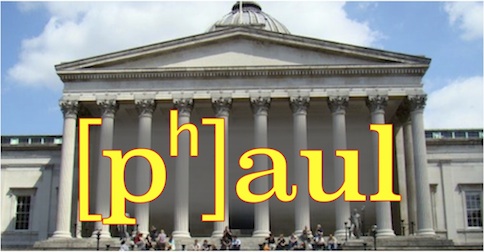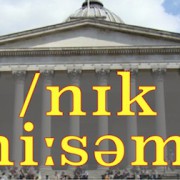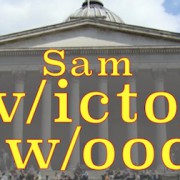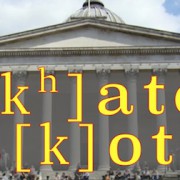Aspirational Paul
 Day 2 of the UCL Summer Course in English Phonetics brings the first of several lectures by Paul Carley of the University of Bedfordshire. Paul is the only SCEP tutor whose names both begin with plosive sounds. In fact they’re both voiceless/fortis plosives, which in English means they’re aspirated.
Day 2 of the UCL Summer Course in English Phonetics brings the first of several lectures by Paul Carley of the University of Bedfordshire. Paul is the only SCEP tutor whose names both begin with plosive sounds. In fact they’re both voiceless/fortis plosives, which in English means they’re aspirated.
In phonetic transcription these plosives are [pʰ] and [kʰ], though the aspiration is generally not indicated in the broad transcription of dictionaries.
I made a video about aspiration which you can see here, and there’s a version with Japanese subtitles here.
Aspiration, like /h/, can be thought of as a whispered version of the following vowel. You can hear this if I exaggerate the aspiration on Paul’s name:
and then isolate the aspirated plosives:
The different qualities of the following vowels (/ɔː/ and /ɑː/ in typical dictionary symbols) are audible in the two whisper-like bursts of aspiration.
Paul’s surname, like mine, ends in what some people call the ‘happY vowel’. For some years British dictionaries have transcribed this with /i/, a symbol which causes quite a bit of confusion as it isn’t a genuine phoneme of English. It’s best thought of as the form of the long FLEECE vowel which appears in the weakest (least stressed) syllables. (Paul and I agree that it might be better to transcribe it simply with the same symbol as any other FLEECE vowel – in typical dictionary transcription, /iː/.)
SCEPlog 1 Postalveolar Jane SCEPlog 2 Aspirational Paul
SCEPlog 3 Sam /v/ictor /w/ood SCEPlog 4 Bob Ladd
SCEPlog 5 Non-rhotic Margaret SCEPlog 6 Devoiced Cris
SCEPlog 7 Unaspirated Scott SCEPlog 8 ‘ng’ as in Inger & Young Shin







Leave a Reply